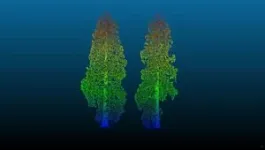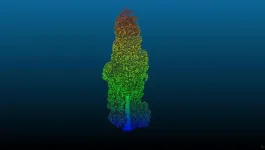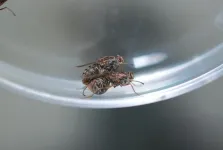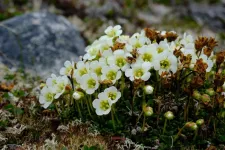(Press-News.org) HOUSTON – (March 13, 2024) – Rice University’s Naomi Halas has been selected as the 2024 recipient of the C.E.K. Mees Medal by Optica for “her design, fabrication, and demonstration of nanoparticles with specific optical and physical properties, the widespread application of which enables advances in fields including cancer therapy, water security, and light-driven chemistry.”
Halas’ groundbreaking work in nanotechnology has enabled the creation of metal nanoparticles possessing structural features designed to interact with light in specific ways that can be deployed in a variety of contexts, including biomedicine, optoelectronics, chemical sensing, catalysis, and water treatment.
“The idea of using light to drive chemical transformations is by no means new, but we needed to have the right platform ⎯ the right type of nanoparticle complex ⎯ to actually make the chemistry happen,” Halas said. “Two of the major applications of our work are for photothermal cancer therapy and plasmonic photocatalysis for hydrogen production.”
Halas is a co-founder of Nanospectra Biosciences, a nanomedicine company whose prostate cancer treatment technology is currently undergoing review by the U.S. Food and Drug Administration, and of Syzygy Plasmonics, which builds light-driven all-electric chemical reactors for affordable greenhouse gas reduction and hydrogen fuel production.
“It just goes to show how important optics and light-based applications are,” Halas said. “Every time people begin to apply light to an interesting problem and really find a solution, it is often very transformative. Optics really can have a profound impact on many different fields, which is why research in this area is often so cross-cutting. It’s exciting to be working in this area at this historical juncture, when we are looking to solve urgent problems in energy and medicine.”
Halas obtained her doctorate in physics from Bryn Mawr College, and, having performed her graduate research at IBM Yorktown, she then served as a postdoctoral fellow at AT&T Bell Laboratories. The first Rice faculty member to be elected to both the National Academy of Sciences and the National Academy of Engineering for research carried out while at the university, Halas was named University Professor, Rice’s highest academic rank, in 2023.
In addition to this year’s C.E.K. Mees Medal, Halas was named an Optica Fellow in 2004 and received the organization’s 2015 R.W. Wood Prize, with Peter Nordlander, Wiess Chair in Physics and Astronomy, and a professor of electrical and computer engineering, and materials science and nanoengineering at Rice.
“What was really wonderful about receiving the Wood Prize was that my IBM thesis advisor, Daniel Grischkowsky, had won it, and his thesis advisor, Sven Hartman, had been awarded it as well,” Halas said. “It was touching to me that three generations of researchers, decades apart, were awarded the same distinction.”
The Mees Medal, which recognizes an original use of optics across multiple fields, honors the memory of Charles Edward Kenneth Mees (1882-1960), whose optics research and innovation helped advance color photography, spectroscopy and astronomy. Mees contributed preeminently and in multiple ways to the development of scientific photography, and was a charter honorary member of Optica (then Optical Society of America). As the Mees Medal recipient, Halas joins a distinguished genealogy of researchers whose work has been critical for the development of optics, enabling its contribution to advancements in a growing number of scientific domains.
Optica, Advancing Optics and Photonics Worldwide, is the society dedicated to promoting the generation, application, archiving and dissemination of knowledge in the field. Founded in 1916, it is the leading organization for scientists, engineers, business professionals, students and others interested in the science of light. Optica’s renowned publications, meetings, online resources and in-person activities fuel discoveries, shape real-life applications and accelerate scientific, technical and educational achievement.
-30-
This release can be found online at news.rice.edu.
Follow Rice News and Media Relations via Twitter @RiceUNews.
Image downloads:
https://news-network.rice.edu/news/files/2024/03/240207_Announcement_Fitlow_002-608d735f5fb9ce05.jpg
CAPTION: Naomi Halas is Rice University Professor and Stanley C. Moore Professor of Electrical and Computer Engineering. (Photo by Jeff Fitlow/Rice University)
Links:
Halas Research Group: https://halas.rice.edu/
Department of Electrical and Computer Engineering: https://eceweb.rice.edu/
Department of Chemistry: https://chemistry.rice.edu/
Department of Bioengineering: https://bioengineering.rice.edu/
Department of Physics and Astronomy: https://physics.rice.edu/
Department of Materials Science and Nanoengineering: https://msne.rice.edu/
Smalley-Curl Institute: https://sci.rice.edu/
About Rice:
Located on a 300-acre forested campus in Houston, Rice University is consistently ranked among the nation’s top 20 universities by U.S. News & World Report. Rice has highly respected schools of architecture, business, continuing studies, engineering, humanities, music, natural sciences and social sciences and is home to the Baker Institute for Public Policy. With 4,574 undergraduates and 3,982 graduate students, Rice’s undergraduate student-to-faculty ratio is just under 6-to-1. Its residential college system builds close-knit communities and lifelong friendships, just one reason why Rice is ranked No. 1 for lots of race/class interaction, No. 2 for best-run colleges and No. 12 for quality of life by the Princeton Review. Rice is also rated as a best value among private universities by Kiplinger’s Personal Finance.
END
Rice’s Naomi Halas awarded Optica’s C.E.K. Mees Medal
Researcher recognized for “original use of optics across multiple fields”
2024-03-13
ELSE PRESS RELEASES FROM THIS DATE:
Giant sequoias are a rapidly growing feature of the UK landscape
2024-03-13
UCL Press Release
Under embargo until Wednesday 13 March 2024, 00:01 UK Time
Imported giant sequoia trees are well adapted to the UK, growing at rates close to their native ranges and capturing large amounts of carbon during their long lives, finds a new study led by UCL researchers with colleagues at the Royal Botanic Gardens, Kew.
The new research, published in Royal Society Open Science, found that the most massive species of redwood trees, Sequoiadendron giganteum, known as the giant sequoia, can potentially pull an average of 85 kilograms of carbon out ...
Who knew that eating poo was so vital for birds’ survival?
2024-03-13
We all know that the early bird gets the worm, but new research shows they turn to something far more nutritious for their breakfast.
Poo – either their own, or from other birds – provides them with essential nutrients, energy, and helps them adapt to new environments and seasonal variations, especially when they are developing.
New research led by the University of South Australia and published in Biological Reviews explains how eating faeces (known as coprophagy) shapes wild birds’ digestive tracts (gut biota), enabling them to absorb lost or deficient nutrients and adjust to seasonal variations in food sources.
This ...
Tsetse fly fertility damaged after just one heatwave, study finds
2024-03-13
The fertility of both female and male tsetse flies is affected by a single burst of hot weather, researchers at the University of Bristol and Stellenbosch University in South Africa have found.
The effects of a single heatwave were even felt in the offspring of heat exposed parents, with more daughters being born than sons.
The study, published today in Proceedings of the Royal Society B, helps explain why tsetse are declining in some parts of their range in Africa and has important implications for the disease they spread, particularly sleeping sickness in humans and nagana in cattle.
Lead author ...
New UAF lidar will add to space weather research capability
2024-03-12
University of Alaska Fairbanks scientists are developing a new light detection and ranging instrument to help gain a better understanding of space weather enveloping Earth.
The new laser radar, or lidar, will be the third for the UAF Geophysical Institute. It will measure temperature and neutrally charged iron in the upper atmosphere at altitudes of 75 to 125 miles, where the mesosphere and thermosphere meet.
Understanding the processes and influences at that altitude has become increasingly important as the proliferation of low-Earth orbit satellites continues and more nations send probes through ...
A simple and robust experimental process for protein engineering
2024-03-12
Image
A protein engineering method using simple, cost-effective experiments and machine learning models can predict which proteins will be effective for a given purpose, according to a new study by University of Michigan researchers.
The method has far-reaching potential to assemble proteins and peptides for applications from industry tools to therapeutics. For instance, this technique can help speed up the development of stabilized peptides for treating diseases in ways that current medicines can't, including improving how exclusively antibodies bind to their targets in immunotherapy.
"The rules that govern how proteins work, from sequence to structure to function, are ...
UTEP researchers to design movement-based training to support local health providers
2024-03-12
EL PASO, Texas (Mar. 12, 2024) – Burnout among health care workers is a well-documented problem that can exacerbate health disparities and limit access to care. Now, researchers at The University of Texas at El Paso are taking a creative approach in their search for a solution – a training program for providers that combines elements of art and science.
The project will examine the impact of a movement-based and somatics cross-training intervention on health care providers in the Paso del ...
Alaska dinosaur tracks reveal a lush, wet environment
2024-03-12
A large find of dinosaur tracks and fossilized plants and tree stumps in far northwestern Alaska provides new information about the climate and movement of animals near the time when they began traveling between the Asian and North American continents roughly 100 million years ago.
The findings by an international team of scientists led by paleontologist Anthony Fiorillo were published Jan. 30 in the journal Geosciences. Fiorillo researched in Alaska while at Southern Methodist University. He is now executive director of the New Mexico Museum of Natural History and Science.
University ...
Study: Best way to memorize stuff? It depends...
2024-03-12
Recent experiments by psychologists at Temple University and the University of Pittsburgh shed new light on how we learn and how we remember our real-world experiences.
The research, described in the March 12 online edition of Proceedings of the National Academy of Sciences (PNAS), suggests that varying what we study and spacing out our learning over time can both be helpful for memory — it just depends on what we’re trying to remember.
“Lots of prior research has shown that learning and ...
Exploring arctic plants and lichens: An important conservation baseline for Nunavut’s newest and largest territorial park
2024-03-12
Encompassing over 16 000 km2 of towering mountains, long fiords, lush valleys, and massive ice caps, Agguttinni Territorial Park is a protected area on northern Baffin Island, Nunavut, Canada. This park, and all of Nunavut, is Inuit Nunangat – Inuit homeland in Canada – and the park protects sites and biodiversity stewarded by Inuit since time immemorial.
Agguttinni means “where the prevailing wind occurs” in the Inuktitut local dialect. The park includes important bird areas, key habitats for polar bears and caribou, and numerous important Inuit cultural sites. It is very remote: no roads lead to it, and access ...
Multiple organ attack and immune dysregulation: Study reveals how the chikungunya virus leads to death
2024-03-12
The chikungunya virus, transmitted by Aedes aegypti and Aedes albopictus mosquitoes and responsible for more than 900 deaths in Brazil since it arrived around ten years ago, is capable of spreading through the blood, reaching multiple organs and crossing the blood-brain barrier, which protects the central nervous system. The mechanisms of action observed for the first time in fatal cases by a group of Brazilian, American and British researchers were reported in an article published on March 12 in the journal Cell Host & Microbe. The findings reinforce the need ...
LAST 30 PRESS RELEASES:
Post-stroke injection protects the brain in preclinical study
Cardiovascular risk score predicts multiple eye diseases
Health: estimated one in ten British adults used or interested in GLP-1 medications for weight loss
Exercise to treat depression yields similar results to therapy
Whooping cough vaccination for pregnant women strengthens babies’ immune system
Dramatic decline in new cases of orphanhood in Uganda driven by HIV treatment and prevention programs
Stopping weight loss drugs linked to weight regain and reversal of heart health markers
Higher intake of food preservatives linked to increased cancer risk
Mass General Brigham–developed cholera vaccine completes phase 1 trial
First experimental validation of a “150-year-old chemical common sense” direct visualization of the molecular structural changes in the ultrafast anthracene [4+4] photocycloaddition reaction
Lack of support for people on weight loss drugs leaves them vulnerable to nutritional deficiencies, say experts
Dogs’ dinners can have greater climate impact than owners’
Are you ready to swap salmon for sprats and sardines?
1.6 million UK adults used weight loss drugs in past year
American College of Cardiology comments on new dietary guidelines for Americans
American Society of Gene & Cell Therapy and Orphan Therapeutics Accelerator partner to advance and commercialize promising rare disease treatments
One in 14 patients having day case surgery have new or worse chronic pain 3 months after their operation
New study highlights link between eviction rates and gun violence
Heatwaves heat up soil but not toxin levels in rice, study finds
Digital modeling reveals where construction carbon emissions really come from
Turning farm waste into water filters
New study shows how the spleen helps the immune system accept a transplant
New Mayo Clinic study advances personalized prostate cancer education with an EHR-integrated AI agent
Researchers identify novel therapeutic target to improve recovery after nerve injury
Microbes in breast milk help populate infant gut microbiomes
Reprogramming immunity to rewrite the story of Type 1 diabetes
New tool narrows the search for ideal material structures
Artificial saliva containing sugarcane protein helps protect the teeth of patients with head and neck cancer
Understanding the role of linear ubiquitination in T-tubule biogenesis
Researchers identify urban atmosphere as primary reservoir of microplastics
[Press-News.org] Rice’s Naomi Halas awarded Optica’s C.E.K. Mees MedalResearcher recognized for “original use of optics across multiple fields”






